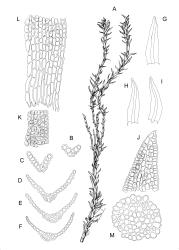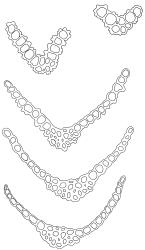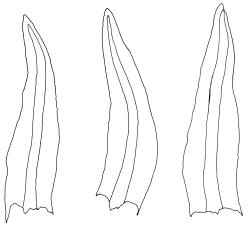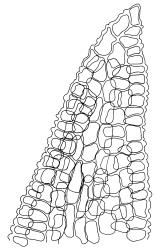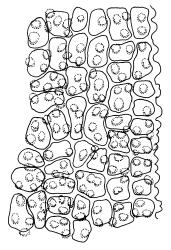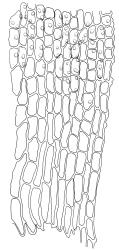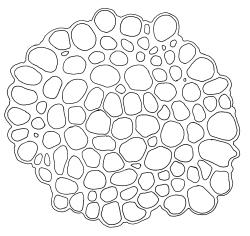- ≡ Gymnostomum recurvirostrum Hedw., Sp. Musc. Frond. 33 (1801)
- ≡ Hymenostylium recurvirostrum (Hedw.) Dixon, Rev. Bryol. Lichénol., n.s. 6: 96 (1934)
Plants medium sized, yellow-green above, light brown below, with a metallic sheen when dry, forming a dense turf of flagelliform shoots. Stems to 80 mm, occasionally branched, central strand absent, sclerodermis becoming strongly developed with maturity, and hyalodermis present but eroding with maturity. Leaves somewhat distant, erect-spreading from a loosely sheathing base and with at least some leaves sigmoid when moist, erect-incurved and slightly individually twisted when dry, (0.6–)0.7–0.8(–0.9) mm, lanceolate, acute; margins plane or narrowly recurved in mid leaf, papillose; upper laminal cells clear in outline, irregularly triangular or quadrate to short-rectangular, moderately thick-walled, slightly thickened at the corners, with 2–4 prominent simple papillae, 7.5–12(–15) × 7.5–10.5 µm, becoming longer towards the leaf base; upper marginal cells in 1 or more rows tending to be shorter than inner cells; lower laminal cells differentiated, gradually transitioning from upper cells, hyaline, rectangular (often with oblique ends), with moderately thick, non-porose, smooth walls, becoming shorter towards the leaf margins. Costa concolorous, stout, failing 3–5 cells before the apex; adaxial superficial cells long-rectangular, thin-walled and smooth throughout; abaxial superficial cells rectangular, papillose, increasing in length and decreasing in papillosity basipetally. Axillary hairs 4–7 cells in length, all hyaline, or basal cell brown, or terminal 1 or 2 cells brown. Laminal KOH colour reaction yellow.
Reportedly dioicous (Zander et al. 2007). Perichaetia, perigonia and sporophytes not seen in N.Z. material.
Saito 1975, fig. 32, 10–26 (as Gymnostomum recurvirostre); Magill 1981, fig. 49, 11–21 (as Hymenostylium recurvirostrum); Lüth 2019, p. 521 (as H. recurvirostrum); Malcolm et al. 2020, p. 480.
Ardeuma recurvirostrum is distinguished by its flagelliform shoots, metallic sheen when dry, narrow leaves tapering from near the base to an acute apex, and a stout costa failing a few cells before the leaf apex. Clumps of shoots show a series of seasonal growth bands, similar to those seen in European material (e.g., R. Hall s.n., AK 363615). The leaf stance is characteristically sigmoid in at least some leaves, either wet or dry. In addition, the stems lack a central strand. In a N.Z. context this species could be mistaken for Gymnostomum calcareum, which may have a similar leaf shape and a stout, failing costa, but does not have a sigmoid leaf stance, nor recurved leaf margins.
SI: Nelson (Mt Owen).
Near cosmopolitan in its distribution, but apparently not recorded in Australia.
Packet details (AK 189685 and CHR 351308) indicate that the specimens were collected from "calcareous soil in marble crevices" at an altitude of c.1800 m on Mt Owen.
Ardeuma recurvirostrum was first recorded for N.Z. (as Hymenostylium curvirostre) by Dixon (1923, p. 117) in error, based on material collected by D. Petrie on Mt Ida, Otago L.D. (BM 000735671). Dixon subsequently revised his opinion, apparently prompted by comments from Sainsbury (see notes with CHR 566192). Dixon annotated the BM specimen "This was a great error ... It is Anoectangium Bellii ". It is in fact an isotype of Anoectangium bellii, having the same collection details, appearance in the packet, and associated Heteroscyphus sp., as three other packets of type material examined (BM 000671542; CHR 566203; WELT M001692).
Ardeuma recurvirostrum was subsequently reinstated to the N.Z. flora on the basis of material collected by J.K. Bartlett in 1983 on Mt Owen (J.K. Bartlett 23082, CHR 351308; WELT M007512), and identified by R.H. Zander. Another specimen, with identical collection details, was lodged in AK (J.K. Bartlett 22940, AK 189685). This latter specimen is a meagre gathering of short, brown, nearly leafless shoots, which nevertheless can be identified as the same taxon. These J.K. Bartlett specimens remain the only confirmed material for N.Z.
Because of the remote, unmodified nature of the single known locality, the species is regarded as indigenous to N.Z. It is classified as "data deficient" (Rolfe et al. 2016).




